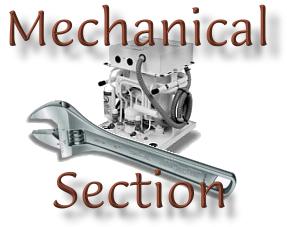|
bertram31.com  Mechanical Section Feature Articles |
Bruce is Owner and Senior Mechanic of Southeast Marine Services, Inc. in the Palm Beach, Florida area. His extensive background, in Marine Mechanical Systems, encompasses both gasoline and diesel engines, air conditioning, and electrical and hydraulic systems.
"Bruce is one of the most 'In Demand' Systems Technicians we have in our area. His expertise is exceptional!"
(Capt Patrick McCrary, webmaster)
|
Basic Diesel
Most of the people I've dealt with over the years have some knowledge of gasoline engines but when it comes to diesels, they seem perplexed and not able to grasp the concept. This article is not going to give you the instruction to rebuild your 10 cylinder Man's, but a simple guide on understanding diesels. There are two major types of diesels, as there are gas engines. Two cycle and four cycle. Cycles stand for the number of revolutions it takes a cylinder to complete a power process. The most common and widely known 2 cycle diesel engine is the Detroit. On the two cycle you have intake(fuel and air) and compression on the same revolution, and power and exhaust on the other. On four cycle you have intake, compression, power and exhaust on 4 different revolutions. As most know, on gasoline the compressed charge is ignited by a spark(spark plug), diesels are ignited by the actual compression which develops heat and ignites the charge. That is why diesels do not have a combustion chamber built into the head, so they can achieve the higher compression of 20:1(can vary) to the gasoline's 8:1. Note: it is not the liquid charge of fuel that is ignited but an atomized or fine mist of air and fuel. This is why gasoline vapors are more explosive than the liquid. Gasoline has an octane rating to determine combustibility, diesels have a cetane rating. The most important thing to remember about fuel no matter what type is to have fresh, clean fuel for proper engine performance. Diesel fuel can have water, algae and decomposition problems. If you don't cycle fuel through your tanks at least every six months, then you should be using a fuel stabilizer and anti algae formula. If you have ever smelled old diesel, it smells just like varnish. It is to a degree. Imagine then what it is doing to your precision fuel injection pump. After fuel leaves the tank, it should go through a primary water separator filter. After the filter it enters a primary fuel pump then usually a secondary filter. Note: on smaller diesels that have a round cylindrical electric fuel pump there is sometimes a filter in a twist off cap inside the pump housing, don't forget to change this. After the secondary filter, it enters the injection pump which boosts the pressure and distributes it to the injectors. There are many styles of injection pumps, space does not permit me to explain all of them, so I'll just touch on the basics. Gear or direct driven injection pumps like distributors have specific timing marks. Plunger style pumps use shims under the pump to adjust timing. What ever the method, timing is crucial to good engine performance, a few degrees off can make a big difference. I ran into a Yanmar 315hp 6cyl. that smoked white from day one. After many hours of testing and diagnosing, I found out it had two sets of timing marks on the flywheel. I had to pull the front gear cover off and align the letters to set it to the proper marks, afterwards the smoking quit. This is a rare occasion though. The fuel is then delivered under pressure to the injectors so that upon leaving the injector it atomizes or vaporizes into a fine mist, upon which it compresses and ignites. If you ever pull injectors out to check the fuel delivery, make sure you don't put your finger over the injector tip to see if fuel is coming out. This fuel misting under high pressure will penetrate your skin, so be careful. Most diesels over 120hp have turbo or blower induction for the incoming air charge, although there are diesels under 100hp that have turbo chargers. This allows more HP and torque(to drive a larger prop) in a smaller package. Natural diesels just use the intake suction of the piston going down to suck in the air. The turbo or blower allows a compressed larger volume of air to be forced into the engine to mix with the fuel. This air when mixed with fuel makes the charge burn much more complete and efficient to develop more HP. An easy way to see this principle work is to blow on hot charcoals, they will glow or start to re burn with the increased air flow. I hope this basic information gives you a better in site on the diesel engine. If you have any specific questions, please go to our forum, also if anyone has a suggestion for a future article, let us know, we're here for you! SMOOTH RUNNING............... Bruce |
Mechanical Feature Articles Mechanical Equipment Reviews Mechanical Service
|| Southeast Marine Sales & Services, Inc. ||
mechanical section / Saturday, February 21, 1998
bertram31.com© 1997,1998 webmaster@bertram31.com Home Page: www.bertram31.com
